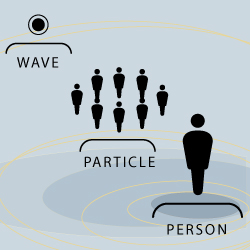
Early in my career, I chose to pursue building personal tools that make us smarter. This developed over time to what I call information flow, a blend of HCI and information retrieval focused on intelligent information discovery and utilization.
The personal computing revolution did not address information flow per se, but rather outfitted us with adequate apparatus. Then came the Internet period, and very quickly (on a historical scale) after the basic mechanics of fetching information were resolved, the focus has shifted to a so-called web 2.0. And calls of "power to the people" obscure the fact that the person may not yet be adequately served.
But, first, let’s consider people. The notion of wavicles, which captures the simultaneous particle- and wave-like properties of light, fits somewhat to our social existence. We are individual particles and participants in wave-like social phenomena that transcend us individually. With this bi-focal lens, you can see how social filtering operates at the two levels and its somewhat-ness as I noted:
- Search — Google PageRank uses links (particle actions) as a wave-like signal on the quality and relevance of particular searches. Well some particles showing they aren’t electrons but rather self-interested rational creatures attempt to game the wave.
- Media Sites — consumers fulfill particular interests by regularly visiting sites shaped by "publishers" sizing up audience waves. Publishers got good in the first place because guessing in print is expensive, but now they are supported by a back-wave of actual action data from their audience tuning their signal.
- Email and Social Networks — people send or post links to particular people or groups of associates or friends, with some of these flows creating broad waves of attention on particular stories or sites.
- Digg — the early tribe-filtering of a SlashDot extended to a much larger but still edge-y side of mainstream with people submitting and "digging" items that crest on say an edge shore for many more to see.
- Blogs — people create a range of content from link shouts and simple statements to complete long form content. All this text is an active digesting of what’s happening at the current edge and the dynamics drive social attention.
- Twitter — the newest super-hot, "mobilizes" and say "micro-tizes" all the above into lightened, quickened use cases like microblogging, near-now-me-casting, live networking, and flash event monitoring.
What you don’t quite see resolved here is the basic issue of a bearable personal experience for the individual. Traditional newspapers and media organizations are lambasted for not having transformed themselves into the brave new world of the Internet and the shift of power to the audience, but isn’t it equally clear that neither the commercial success of the technology disruptors nor a social wavicle lens (call it 2.0 if you must) exactly shed light on where we will arrive in some rationalized future.
Newspapers did once upon a time fit nicely in people’s lives. The additional media of radio, then TV got absorbed into the mix to create a robust overall system. Now, we are clearly in the broken in-between period and it seems our expectations of what must be integrated are only expanding. Sure, wisdom of crowds, but what about the person set in oscillating social rings and individual activities & interests.
It will sort itself out, for sure, by design and by emergence. We’re about half-way there, methinks. And you?



Join the Discussion (0)
Become a Member or Sign In to Post a Comment